Disclosure: We may earn commissions if you purchase products after clicking on a link from our site.
Lingcod is an aggressive fish that lives around structures. Would you like to learn how to catch lingcod? It is a hunter in the true sense of the word. Lingcod is an ambush predator. It can be challenging to catch this fish as you have to navigate rocky bottom structures to get lingcod. In this article, we will discuss the fishing techniques, tips, behaviors, and equipment needed to be successful when fishing for lingcod.
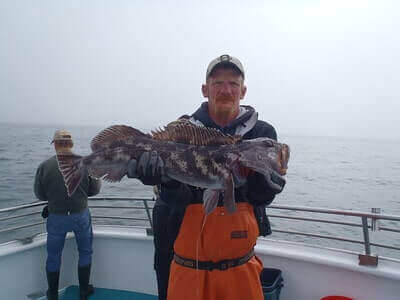
Table of Contents
How To Catch Lingcod
1. Drift fishing
When fishing for lingcod with lures, look for structures such as reefs, rock piles, ledges, jetties, and sea mouths. Drift over the structure with your lures near the bottom where this fish lives. When fishing lingcod with dead bait, after locating the area you want to fish for lingcod, position the boat up-current so the boat drifts over it. When fishing for lingcod with live bait from a boat, place the rod in a rod holder and drop the bait to the bottom, and reel it up slowly until it is just above the ocean floor.
Lingcod violently grabs the bait. When this happens, don’t rush to grab the rod. Don’t set the hook. Instead, gently take the rod out of the holder and with a slow and steady retrieve, reel in the fish. Have a net ready before it reaches the surface and place the net underneath the fish before it gets spooked and lets go of the bait.
2. Vertical Jigging
Vertical jigging is also very productive when fishing for lingcod. The up-and-down motion will get the attention of the fish. When you jig, move the lure up and down in 4-foot increments. Continue jigging over a hotspot and don’t stop.

3. Trolling
Trolling is another effective method for catching lingcod, particularly in open water or along rocky coastlines. Anglers deploy trolling rigs equipped with large, heavy lures or baited hooks behind a moving boat. The motion and vibration of the lures mimic the movement of injured or fleeing baitfish, enticing lingcod to strike. Trolling allows anglers to cover a wide area and search for active lingcod while exploring different depths and underwater structures.
4. Bottom Fishing
Bottom fishing is a classic technique for targeting lingcod, especially around rocky reefs, ledges, and underwater structures where these fish are commonly found. Anglers use heavy sinkers to bring their baited rigs to the seafloor, where lingcod often lie in wait for passing prey. Baits such as live or dead fish, squid, octopus, or shrimp are commonly used to attract lingcod. Patiently presenting bait on or near the bottom increases the chances of enticing lingcod to bite.
5. Jigging
Jigging is a popular method for catching lingcod, especially in rocky or structure-rich areas where these predatory fish lurk. Anglers use heavy jigs with colorful and enticing designs to mimic the movement of prey fish. By rapidly raising and lowering the jig through the water column, anglers can attract the attention of lingcod and induce strikes. Jigging allows for precise depth control, making it effective for targeting lingcod at various depths.
How To Catch Lingcod From Shore
The most important aspect of fishing from the shore is to find the right spots to target. When fishing for lingcod from the shore, look for structures like piers, reefs, drop-offs, jetties, kelp, and rocks. Lingcod will be hanging around those structures preying on bait.
Lingcod is an attack-minded fish and if you find the right spot, and have the right lures and bait, your chances of catching them increase dramatically.
Squid, eel, mackerel, sand dabs, and anchovies are some of the baits that you can use when fishing for lingcod. When fishing from the shore, most of the time you will be casting your bait into the water.
How To Catch Lingcod In California
When fishing for lingcod in California, look for structures such as reefs, rocky areas, drop-offs, jetties, and kelp. You can use a fish finder to find these areas to target. Drop your line slowly or jig close to the structures to get a bite.
When fishing for lingcod in rocky areas, your line can easily get caught up with the rocks. Once you realize it is caught among the rocks, release more lines to free up the line from the rocks.
How To Catch Lingcod In Washington
When fishing for lingcod in Washington, look for structures off the bottom. Rocky ledges, jetties, reefs, breakwaters, drop-offs, and rock piles are good areas to look for them. Get your line to the bottom and bring it up a bit so that it is off the bottom.
Lingcod Tackle Setup
There are many options for a tackle for lingcod fishing. A general one would be an 8 to 10-foot fishing rod with a spinning reel that holds between 150 to 250 yards of 40-pound braid. Additionally, a medium-weight conventional rod can also work for lingcod fishing.
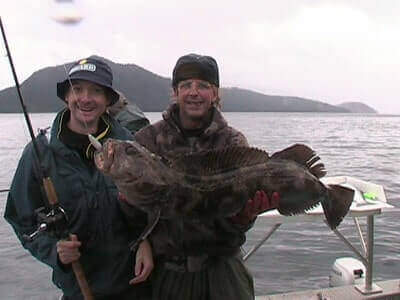
Best Bait For Lingcod
1. Mackerel
Mackerel is an excellent bait choice for targeting lingcod due to its oily and strong-smelling nature, which can attract these predatory fish from a distance. Anglers often use fresh or frozen mackerel as cut bait, filleted into strips, chunks, or whole pieces, depending on the size of the lingcod being targeted.
The oily flesh of mackerel releases scent and oils into the water, enticing lingcod to strike. When rigging mackerel as bait, anglers may use a variety of methods, such as threading it onto a hook, jig head, or bait rig, to present it effectively to lingcod. Whether drifted along the bottom, jigged near structure, or trolled behind a boat, mackerel can be a highly effective bait for enticing lingcod to bite.
2. Anchovies
Anchovies are a popular bait choice for lingcod fishing, appreciated for their strong scent and natural oils that can attract these voracious predators. Anglers often use fresh or frozen anchovies, either whole or cut into chunks, to entice lingcod strikes.
The scent trail produced by anchovies in the water can effectively draw lingcod towards the bait, especially when presented near rocky structures or drop-offs where lingcod commonly inhabit.
When rigging anchovies as bait, anglers may thread them onto a hook, jig head, or bait rig, ensuring they are securely attached to withstand the lingcod’s powerful strikes. Whether drifted along the ocean floor or jigged in deeper waters, anchovies can be a reliable choice for anglers targeting lingcod.
3. Herring
Herring is a favored bait option for anglers targeting lingcod due to its strong scent and natural oils, which can attract these predatory fish. Whether fresh or frozen, whole or cut into chunks, herring emits a potent scent trail that entices lingcod to strike.
Anglers often rig herring on hooks, jig heads, or bait rigs, ensuring the bait is presented effectively near rocky structures, reefs, or drop-offs where lingcod commonly lurk.
The oily texture and robust flavor of herring make it an irresistible offering for lingcod, particularly when fishing in deeper waters where these ambush predators hunt. Whether drifted along the ocean floor or jigged near underwater structures, herring can increase the chances of hooking into a sizable lingcod.
4. Flounder
Flounder serves as an effective bait choice when targeting lingcod, especially in areas where both species coexist. The flat, oval shape and natural movement of flounder mimic the profile of other prey fish, making it an enticing meal for lingcod.
Anglers typically use fresh or frozen flounder, either whole or filleted, to entice lingcod into striking. Rigging flounder on a hook or jig head allows for a presentation near the seafloor or around underwater structures where lingcod often hides.
Flounder emits a scent that can attract lingcod from a distance, enticing them to investigate and potentially strike the bait. With its natural appearance and appealing odor, flounder can be a reliable bait choice for anglers targeting these prized bottom-dwelling predators.
5. Greenling
Greenling can be an effective bait option when targeting lingcod, particularly in regions where both species inhabit the same waters. Greenling, with its robust body and firm texture, can withstand the rigors of being used as bait and remains attractive to lingcod.
Anglers often use fresh or frozen greenling, either whole or cut into chunks, as bait. The natural oils and scent released by greenling can attract lingcod, enticing them to strike.
When rigged properly on a hook or jig head, greenling can be presented near the seafloor or around underwater structures where lingcod are known to lurk. Its distinct coloration and movement can make it stand out among other bait options, making it a valuable choice for anglers seeking to entice lingcod into biting.
6. Squid
Squid is a popular and effective bait choice when targeting lingcod due to its availability, durability, and attractiveness to these predatory fish. Lingcod are known to be voracious feeders and are attracted to the scent and movement of squid.
Anglers often use fresh or frozen squid, either whole or cut into strips, as bait. The soft texture of squid allows it to flutter enticingly in the water, mimicking the movements of natural prey.
Additionally, squid releases natural oils and scents that can attract lingcod from a distance. When rigged properly on a hook or jig head, squid can be presented near the seafloor or around rocky structures where lingcod is commonly found. Its versatility and effectiveness make squid a go-to bait option for anglers targeting lingcod in various coastal habitats.
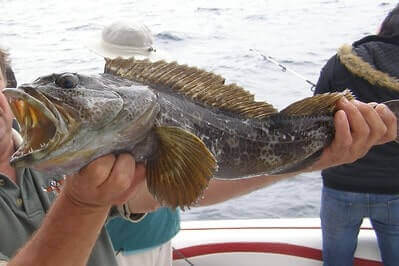
Lingcod Fishing Rigs
1. Herring Rigs
The herring rig is a popular choice among anglers targeting lingcod due to its effectiveness in imitating the appearance and movement of natural prey. This rig typically consists of a weighted jig head or a sliding sinker attached to the main line, followed by a leader line equipped with one or multiple hooks.
Anglers often use fresh or frozen herring as bait, which is secured onto the hooks either whole or in chunks. The realistic profile and natural scent of herring make it highly attractive to lingcod, enticing them to strike. The herring rig can be deployed near the seafloor or along rocky structures where lingcod is commonly found.
Anglers may also add additional attractants such as scents or flashers to enhance the rig’s effectiveness. Overall, the herring rig is a reliable choice for anglers seeking to catch lingcod in coastal waters.
2. Metal Jigs
Metal jigs are versatile and effective fishing rigs for targeting lingcod in various marine environments. These rigs typically consist of a weighted metal lure designed to imitate the movement of baitfish or other prey species. Anglers can choose from a variety of jig designs, including butterfly jigs, knife jigs, and vertical jigs, each offering unique swimming actions and profiles.
Metal jigs are favored for their ability to reach deeper depths quickly and maintain precise control during retrieval. Anglers often deploy metal jigs by jigging them up and down or by casting and retrieving them along the seafloor or near underwater structures where lingcod are known to inhabit. The shimmering and fluttering motion of metal jigs coupled with their realistic appearance makes them irresistible to lingcod, enticing aggressive strikes.
Furthermore, metal jigs can be rigged with single or treble hooks, allowing anglers to customize their setups based on the target species and fishing conditions. Overall, metal jigs are a reliable choice for anglers seeking to catch lingcod in both shallow and deep-water environments.
3. Live Bait Rigs
Live bait rigs are highly effective fishing setups for targeting lingcod, especially in areas where natural prey species are abundant. These rigs typically consist of a sliding sinker or a bottom rig with a leader line attached to a live baitfish or other live bait species. Anglers can use various live baits such as mackerel, anchovies, herring, flounder, greenling, and squid, depending on local preferences and availability.
The live baitfish is hooked through the lips, back, or tail to allow for natural swimming motion, enticing lingcod to strike. Anglers can deploy live bait rigs by drifting or anchoring near rocky structures, kelp beds, or underwater ledges where lingcod typically hide and ambush their prey.
The natural movements and scent of live bait make them irresistible to lingcod, often resulting in aggressive strikes and successful hookups. Additionally, live bait rigs offer anglers versatility in adjusting bait size and species to match the preferences of the targeted lingcod population. Overall, live bait rigs are a tried-and-true method for enticing lingcod and are favored by many anglers for their effectiveness in catching this prized species.
4. Swimbaits
Swimbaits are increasingly popular among anglers targeting lingcod, offering a versatile and effective option for enticing these predatory fish. These fishing rigs typically consist of a lead jig head with a soft plastic swimbait body attached. The swimbait body mimics the appearance and swimming action of natural prey, such as small fish or squid, making it highly attractive to lingcod.
Anglers can choose from a variety of swimbait sizes, colors, and designs to match the local forage and conditions. Swimbaits can be rigged weedless or with an exposed hook, allowing them to be fished effectively around rocky structures, kelp beds, and other lingcod habitats without snagging. Anglers can use a steady retrieve or vary the speed and cadence to mimic injured or fleeing prey, enticing strikes from lingcod lurking below.
Swimbaits are versatile and can be fished at various depths, making them suitable for both shallow and deep-water lingcod fishing. Overall, swimbaits offer anglers a realistic and enticing presentation that can yield impressive results when targeting lingcod in a variety of environments and conditions.
5. Plastic Grubs
Plastic grubs are a tried-and-true option for lingcod fishing, offering anglers versatility and effectiveness in enticing these voracious predators. These fishing rigs typically consist of a lead jig head with a soft plastic grub body attached. The grub body is designed to mimic the appearance and movement of natural prey, such as small fish or crustaceans, making it highly appealing to lingcod.
Anglers can choose from a wide range of grub sizes, colors, and tail designs to match the local forage and water conditions. Plastic grubs can be rigged with a weedless hook or an exposed jig head, allowing them to be fished effectively around rocky structures, kelp beds, and other lingcod habitats without snagging.
Anglers can employ a variety of retrieval techniques with plastic grubs, including steady retrieves, hops, twitches, and pauses, to mimic injured or fleeing prey and entice strikes from lingcod lurking below. Plastic grubs are versatile and can be fished at different depths, making them suitable for both shallow and deep-water lingcod fishing.
Overall, plastic grubs provide anglers with a reliable and lifelike presentation that can produce excellent results when targeting lingcod in various environments and conditions.
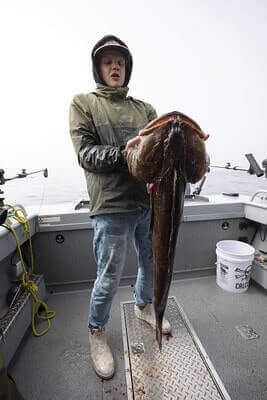
Lingcod Fishing Tips
1. Lingcod live around structures like reefs, rock piles, ledges, jetties, and sea mouths.
2. Lingcod likes areas with heavy currents.
3. A dark and rocky lair that features camouflage and currents to bring prey is the ideal hiding spot.
4. Lingcod do not have swim bladders to regulate their depth.
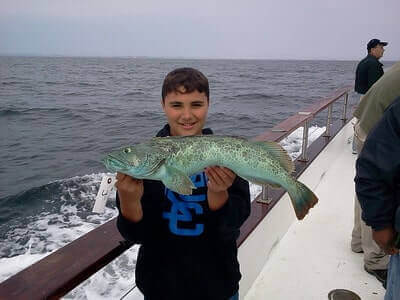
5. A strong vertical movement of the lure will get the attention of lingcod’s attention.
6. Live bait is the best bait to fish for lingcod.
7. Lingcod violently grabs the bait. When this occurs, do not rush to grab the rod. Also, don’t set the hook just yet. Instead, take the fishing rod and with a slow and steady retrieve, reel in the lingcod.
8. Always have a net ready before the fish is near the surface and put the net underneath the fish before it lets go of the bait.

9. Lingcod is good to eat and is tasty.
10. Drifting is one of the popular fishing techniques used by anglers to catch lingcod.
11. Lingcod bites at any time of the day.
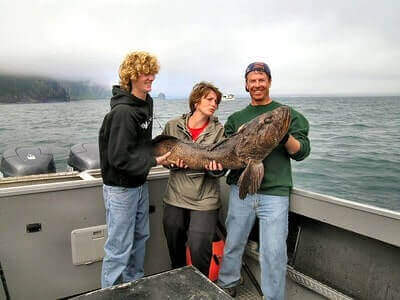
12. Lingcod spawning season runs from December to early spring.
13. The weather and oceanic conditions have a greater effect on when lingcod will be active.
14. Vertical jigging is one of the best fishing techniques to catch lingcod.
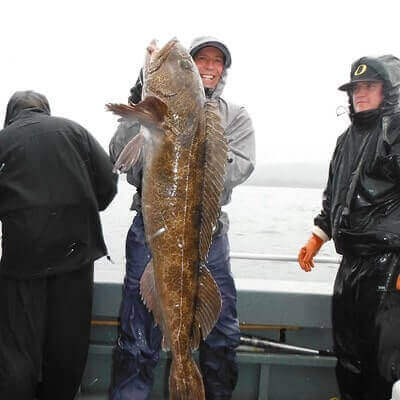
15. Female lingcod are usually larger than males and are found in deeper water with depths of 150 feet or below. If you want to catch larger lingcod, you will need to go deeper and use the heavyweight gear.
16. If you want to catch a lot of lingcod, look for underwater pinnacles using charts and GPS. If you can find areas that are 100 ft on all sides and the pinnacle comes up to 20 ft in depth, then you have a good spot to fish for lingcod.
17. Always position your boat so that the currents and tides push the boat from shallow to deep to avoid snagging the bottom.
18. When picking tides for drifting, opt for a tide change of fewer than 10 inches. This will ensure that the current will not be too fast.
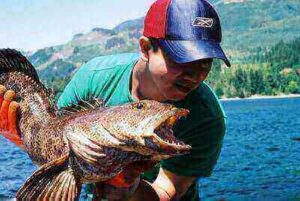
19. Lingcod will almost always strike the jig as it is falling.
20. When you fish for lingcod from the shore, look for areas that will put you in casting range of deep water, rocks, and kelp.
21. When you fish a new spot for lingcod, start by fishing high in the water column until you discover where the underwater structures are located. Then fish deeper and closer to the structures until you start to snag and then adjust.
22. To catch lingcod and avoid snagging, keep the lure moving around the structure. Two retrieval methods that you can use are the “lift and drop” jigging technique and the “slow reel” swimming technique.
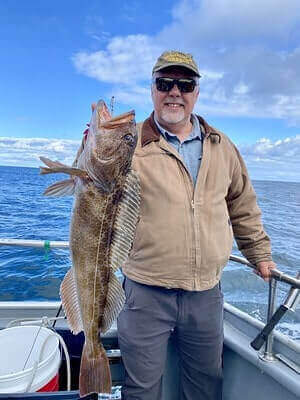
23. The best opportunity to catch a lingcod is to fish on a calm day and fish in a deep spot on the incoming tide.
24. When hooked, lingcod will initially lunge to strike and then move for the rocks.

The Bottom Line
Lingcod is one of the favorites of anglers as they put up an aggressive fight, have a unique appearance, and are good to eat. It is found on the Pacific coast off of Oregon, Washington, Alaska, and certain parts of California. Using the right fishing techniques, bait, and equipment, and looking in the right areas, fishing for lingcod can be fun, and rewarding.
If you also fish for other fish like cabezon, chain pickerel, flathead catfish, and bream, you can read how to catch cabezon, how to catch chain pickerel, how to catch flathead catfish, and how to catch bream.